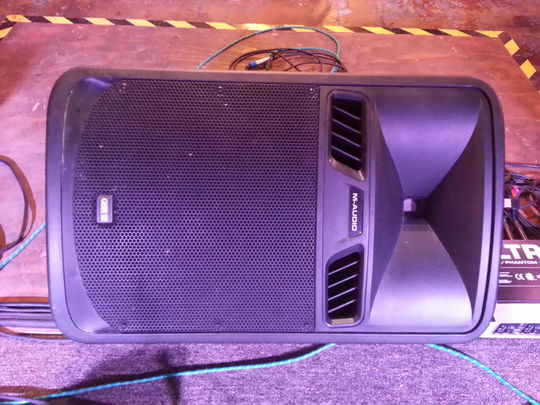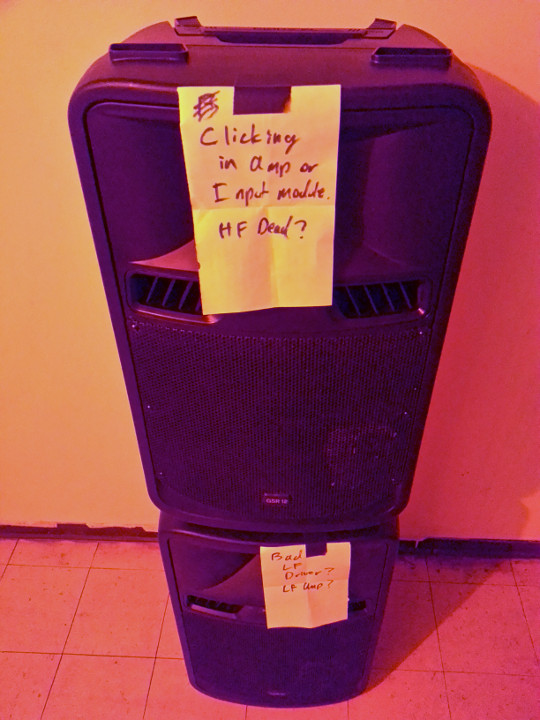Sometimes, even well-respected manufacturers will produce an uncharacteristic dud. Such is my experience with the GSR-12 by Avid/ M-Audio.
Please Remember:
The opinions expressed are mine only. These opinions do not necessarily reflect anybody else’s opinions. I do not own, operate, manage, or represent any band, venue, or company that I talk about, unless explicitly noted.

 Out of six GSR-12s originally purchased, only three have survived. Here’s one of the units that still works.
Out of six GSR-12s originally purchased, only three have survived. Here’s one of the units that still works. There’s another GSR that you can’t see here. That one’s completely dead, and in another closet. These are the two that I could get to without a lot of fumbling around.
There’s another GSR that you can’t see here. That one’s completely dead, and in another closet. These are the two that I could get to without a lot of fumbling around.I wanted to do this article as a traditional review. In that review, I would have strongly recommended that people avoid purchasing these loudspeakers.
I was foiled by these units having been close-outs for a while. It seems that all the stock has either been sold, or otherwise removed from saleable inventory.
The damage is done, I guess.
With that being the case, I had to cast about a bit for some wider context. So, what’s the story?
A ways back, maybe about a year, it had come time for Fats to graduate from the Peavey PR-10P wedges I was bringing in for stage monitoring. I worked up a short list of boxes that I felt would do the job, and could be acquired in good numbers for a manageable amount of cash.
And then, “it” hit. “It” being a blowout sale of biamped, self-powered (active) loudspeakers. From what I could see, GSR series units were being pushed out the door for cost plus just a bit more. Having owned various pieces of M-Audio gear beforehand, I thought to myself, “These guys make a quality product. It would be dumb not to jump on this.”
I figured my reasoning was sound. (“Sound,” ha! Get it? Sound? Small joke, there.) On a weekly basis, I trust our shows to my homebrew digital mix rig. That rig is built around an M-Audio Profire 2626. That unit had always been rock solid, so why wouldn’t the GSRs be the same way? I had a suspicion that the model line was being phased out, and that a new crop of boxes was the reason for the “fire sale” Hey, I could live with last year’s model.
In retrospect, I think M-Audio was getting rid of a lackluster product that didn’t turn out well for them. Evidence? Well…
I talked management into ordering six units. They all arrived and fired up without issues, but within a few days, half of them developed a strange problem. Their output level had dropped dramatically. As it turns out, there was some issue with their input volume potentiometers. If you popped open a box, and shorted the input and output terminals for the volume controls, the “low volume” problem went away.
Yes, I was dinking around inside boxes that were attached to mains power and running. No, I don’t recommend that people try this at home, or anywhere else. If you do end up trying something like this, death or injury is your own fault – not mine.
This should have been a warning. A six-box install losing half its units to a manufacturing defect doesn’t bode well. One box being a problem-child is something that happens, but three units out of six? All with the same issue? Uh-oh…
Anyway, I got out my soldering iron and voided a warranty by doing a permanent, volume-knob bypass. I decided to try living with the other two. (You could still coax them into full volume by pushing, pulling, turning, and tweaking the volume knob, and then hoping that whatever was making contact would stay in contact.) Then one night, during the second-half of a Beatles tribute act’s show, my “surgically enhanced” GSR quit entirely. No sound, no power, no lights, nada.
Dangit!
At that point, I asked the bosses to send the two remaining problem-children out for service.
They came back with their volume pots working correctly. Good times!
Several months passed, and then odd things started to happen again. One of the GSRs started making this strange “click” or high-frequency “pop” every so often. The odd noise “stayed with” the unit when I put it on different console outputs. Then, one day, its HF (high frequency) section quit working entirely.
Bummer.
A little while later, while setting up for a show, I discovered that a different unit had decided that the LF (low frequency) part of the deal was no longer something it wanted to uphold. I did get a chance to try swapping LF drivers around, and I’m pretty sure both drivers I tried were good. I’m not 100% positive, though.
Anyway…
I’m back down to three units out of six. I’m hoping the others hang on until I can find something to replace them. The issues described above occurred in concert with some other observations I’d like to share:
- I never tried any in-box EQ, other than the “flat” mode. In the flat configuration (with some external EQ), the GSR-12s have this strange property of sounding fine with playback, but having this weird, honky, hard-ish to tame region around 500 Hz when used as a monitor for vocal mics. I’ve noticed this behavior across mics from Sennheiser, Samson, Peavey, and Shure. Maybe it’s just the mics that get used regularly, or maybe part of it is the room. Still…
- That odd, honky, unpleasant, hard to tame midrange was something that I noticed on the first day of using the boxes, and took a while to get under control. The units were touted as “a studio monitor for live sound,” but they sure didn’t sound like a studio monitor to me. (Again, the room plays a factor. Nevertheless.)
- The transition or, shall we say, acoustical crossover between the LF driver and the horn seemed really, really obvious to me. I would stand a bit more on axis with the LF driver, and the horn’s contribution seemed to really drop off. Then, I would move toward the horn, and its output would seem to dominate just a bit more than it should. There was this odd “hole” in between. I thought it might have been a consequence of where the enclosure’s ports are located. However, my first-gen JBL Eons have a similar port location, and they have a much smoother (maybe even seamless) transition from the LF to the HF section.
- To swerve the topic a bit, I just visited M-Audio’s website today. The “products” section contains nothing that is purely aimed at live sound. Nothing. At all. The implication is that they weren’t really committed to live-sound as an added focus for the company – they wanted a piece of the action, but they might not have been really serious about it. When it didn’t go well, they just cut their losses and moved on. (Nothing really wrong with that.)
So, all of this plays into my notion that the killer pricing we got was M-Audio offloading a troublesome line of goods. Like I said in the last bullet point, my guess is that they made a foray into an area that they weren’t really prepared for (live sound reinforcement), and ended up with a result that wasn’t executed very well.
But here’s the thing.
I have a suspicion that their planning was perfectly good.
Like I said earlier, I’ve had other M-Audio products, and have been pretty darn happy with all of them. I know that the company can create good gear. My overall suspicion is that the GSR-12 (and probably the whole GSR line) was an uncharacteristic dud – a product that just didn’t live up to anyone’s expectations. If I had my guess, I’d say that the design folks tried to transfer the studio monitor team’s experience into a bigger, louder box, and partially succeeded. In fact, I’d be willing to bet that the first few prototypes were pretty good. However, I also have a notion that the mass manufacture part of the equation “got away from them,” or wasn’t managed correctly, and the actual consumer units were disappointing.
The good news is that M-Audio has a number of product lines that are a fine value. I do encourage you to buy the units that the company has always been good at building – like their audio interfaces.